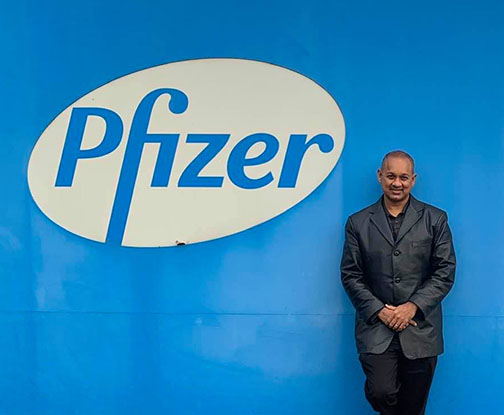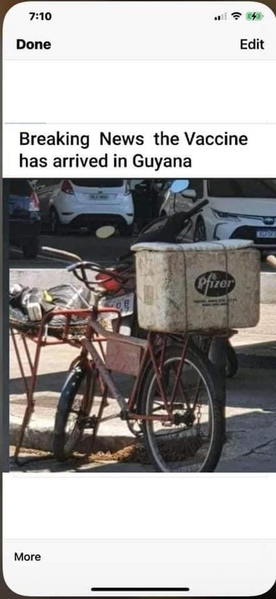This Caribbean Born Scientist Worked On The Development Of The Pfizer COVID-19 Vaccine

Pfizer’s principal research scientist, Vidia Surendra Roopchand. (Pfizer contributed image/News Americas)
News Americas, NEW YORK, NY, Weds. Dec. 23, 2020: A lot has been written already, and more needs to be said, of the Caribbean-born doctor, Dr. Michelle Chester, who delivered the first COVID-19 Pfizer vaccine in the US and of the Caribbean-born nurse, Sandra Lindsay, who was the first in the US to receive the shot. But few know that one of the scientists who helped create the much-needed COVID-19 vaccine, BNT162b2, was also born in the Caribbean region.
Pfizer’s principal research scientist, Vidia Surendra Roopchand, was born in the CARICOM South American nation of Guyana and News Americas recently caught up with him exclusively to get his thoughts not that the vaccine has become a reality.
Asked how he feels to be making history as an immigrant and a Caribbean immigrant from Guyana, as part of the team to deliver the first vaccine to possibly help curb the COVID-19 virus, Roopchand said “it was a humbling experience more than anything else!”
“I also feel honored and fortunate that I was able to contribute to the team effort that delivered the first COVID-91 vaccine to the world,” added the 53-year-old scientist, who grew up on the tiny island of Wakenaam, located in the Essequibo River In Guyana.
He credits his educational foundation and life experiences in the Caribbean and Guyana. “This is also an American story, I have represented Guyana and Caribbean in this effort but it is also an embodiment of the of the American dream and the great things that are possible in America,” he added.
QUESTIONS ON RACE AND THE VACCINE
Asked for his message to immigrants and people of color who because of past history, are hesitant about the vaccine and taking it when it becomes more widely available, Roopchand said that “for every successful vaccine that I have worked on during my career at Pfizer, I have always asked myself the following question. ‘Would I take this vaccine, and would I recommend this vaccine to a loved one?.”
“The answer to this question has always been a resounding ‘Yes,’” he said. “I will take this vaccine and I will recommend this vaccine to any of my loved ones. My wife is taking it today (Dec. 21, 2020), at her hospital (NYP Bronxville).”
The top Pfizer scientist revealed that the development of the BNT162b2 vaccine has been “thorough and transparent to the regulatory agencies around the world.”
“The data has been presented to the leading infectious disease experts in the world and representatives from the anti-vaccine movement as well,” said Roopchand. “The data from the clinical trials are available in the public domain so people can see for themselves what the regulatory agencies had to say. There are also interviews with vaccine recipients which are available.”
He revealed that as far as side-effects, vaccinated subjects should anticipate potentially feeling fatigued or experiencing headache, chills or muscle pain shortly after getting immunized. But he said,” that is to be expected.”
“It just means that your immune system is working,” Roopchand explained while reiterating that people with allergies to any of the vaccine components should not get the vaccine.
The vaccine contains mRNA, lipids, potassium chloride, monobasic potassium phosphate, sodium chloride, dibasic sodium phosphate dihydrate, and sucrose, he revealed.
GROWING UP
Named after the late Nobel Prize-winning West Indian author V.S. Naipaul, Roopchand, according to a profile on Newsroom Guyana, is the eldest of three children of retired school principals.
He discovered his interest in chemistry as a little boy of 11, who began his formal education at the Sans Souci Methodist School and then the Anna Regina Multilateral School. He graduated from the University of Guyana in 1990 and then migrated to New York, and went on to pursue two master’s degrees – one in Immunology from New York Medical College and one in Chemical Engineering from Columbia University.
Soon after he landed at Pfizer, never dreaming that in 2020 he would be a part of history in the midst of a global pandemic.
THE WORK
“The courage and boldness required to make this vaccine was something at which I marveled during the last ten months,” he revealed to News Americas. “We were bold in this effort, but we were constantly aware that failure was always possible because this was a new technology which was being evaluated, that is why I said that it was a humbling experience.”
Roopchand said the team that worked on the project “knew that the world was depending on us to deliver this vaccine and this motivated and inspired us to do our very best.”
“As one of the few organizations in the world which can make vaccines, we all understood that we had a social and patriotic responsibility to get this done,” he added. “I did not become a scientist to do easy things, I did not get graduate degrees in immunology and chemical engineering to do predictable tasks. I love challenges, I cannot accept the status quo in medicines and vaccines, I constantly want to make public health better. … Pfizer penicillin moment was in 1942, …. this is our generation’s ‘Pfizer moment.’”
THE PROCESS AND TOLL PERSONALLY
Roopchand said the first few weeks were quite grueling working on the vaccine, “because so many vaccine candidates had to be evaluated and I was leading the group which provided the cells required for the expression studies, and I was also assisting with some of the immunological studies.”
“This meant that I had to do a lot of juggling between my tasks, some days were longer than others, but the adrenaline kicked in and got me through,” he revealed. “Interestingly, the days of the week started having a different feel during all of this because we were working seven days a week and in constant communication with our BioNTech collaborators in Germany who were in a different time zone. …. We did not get to the ‘mattresses on the plant floor”’ scenario like they did in 1942 at Pfizer Brooklyn (for penicillin) but the experience was quite disruptive on our daily routine.”
He said that balancing family and professional duties also proved challenging but credits his mother-in-law for helping both him and his wife, Nadia, a registered nurse and frontline worker, make it through.
HIS MESSAGE TO CARIBBEAN YOUTH WANTING TO FOLLOW IN HIS FIELD
Roopchand has a simple message to young immigrants and Caribbean nationals wanting to follow in his footsteps. “Dare to dream,” he said. “As President Thomas Jefferson said, ‘We must be bold in our pursuit of knowledge, never fearing the path of truth and reason and the answers it may yield.’ Don’t let the fear for failure discourage you from attempting grand objectives in life.”
Addressing failure, which many youth struggles with today, the Guyanese national noted that “failing at something does not make you a failure, it just means that you attempted something and found out that it was not right for you.”
“Then you can go on to something else but at least you know what is not right for you. Find your passion while keeping in mind that your passion may change as you experience new things in life,” he added. “Develop social skills as well as academic skills, be resilient, believe in yourselves, choose your friends carefully, your friends who correct you when you do something wrong are your true friends.”
PARTING WORDS
“The world is going to emerge from this pandemic stronger and you need to earn your place in this world which is being defined more and more by technology,” Roopchand added. “We are on the cusp of a fourth industrial revolution and the Guyanese and Caribbean education system will give a foundation for you to be part of this.”



